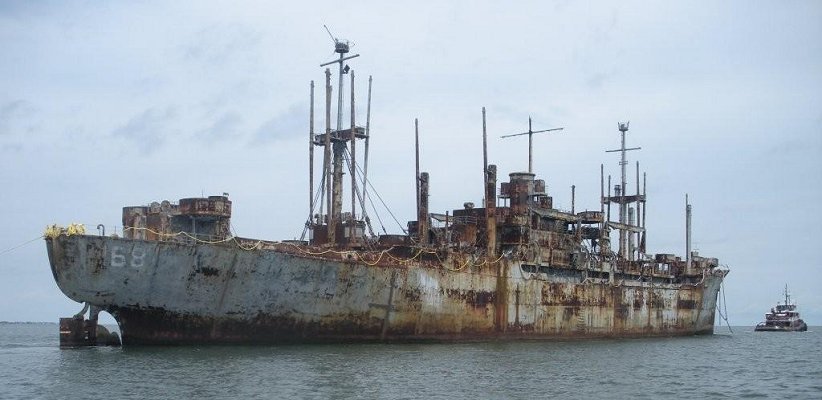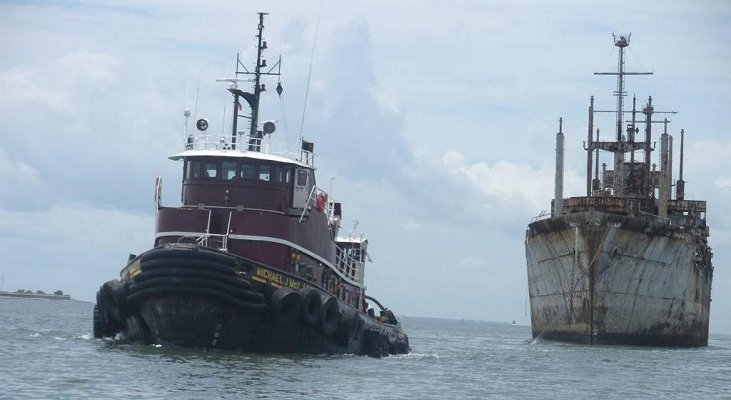
The Last Journey for the USS Gage
By E.B. Fletcher and Kevin Eley

The Last Journey for the USS Gage By E.B. Fletcher
On Thursday, July 23, 2009, the aged creaking hulk of the once proud USS Gage slowly made her way from the James River Reserve Fleet for her last journey to Brownsville, Texas where she will be demolished. The Gage stoically cooperated with the McAllister tugs which were assigned to tow her from Hampton Roads.
The Gage's weather beaten hull was blotched with rust hiding any prior Navy gray paint. Her anchors were gone and the only visible sign of any life aboard this forgotten lady were the remnants of an abandoned Osprey nest cradled within one of her forward masts. The Gage (APA-168) was an amphibious/attack transport designed to sail to the site of amphibious operations carrying assault troops and support equipment during World War II.
These ships had the capacity to hold a full battalion of troops and disembark them with their own landing craft. Ships of this nature today are now called "LPA's" (vapotter.com).
Liberty ships were deemed "ugly ducklings" by former President Franklin Roosevelt. Officially this class of ships was known as the Emergency C2-type, or the EC2s. Their purpose was to free Europe from the oppression of dictatorship and thus became known as "Liberty ships." The first Liberty ship was named Patrick Henry. She was built by the Bethlehem-Fairfield Shipyards, Inc.
The Liberty ship was similar in design to the British emergency ships, except that they had oil water tube boilers instead of Scotch boilers coal-fired. Gibbs & Cox developed the working plans for all Liberty ships and purchased all materials and equipment for the construction of the first 312. This first group of ships was built by nine different ship yards. However, as the techniques of the ships' mass production came to be understood and as experienced plant directors became available, it was only necessary for Gibbs & Cox to distribute plan reproductions and related data to the shipyards building the 2, 308 remaining Liberties (Cox, 1968).
The Liberty ship program was the greatest single shipbuilding project of all time. It was also one of the greatest moral builders of the early war period. The first Liberty ship took 147 days from keel laying to launching. As the mass production of these ships became an art, the number of days it took to produce a Liberty was significantly reduced. One ship, Joseph N. Teal, was built in just 10 days from keel laying to launching (Cox, 1968)!
The Gage was decommissioned in 1947 after only three years at sea; yet, during those three years, the Gage received a battle star for her service in World War II - The Battle Star was awarded for her service in the Okinawa Invasion (vapotter.com). The USS Gage was the last example of a Haskell - class attack transport which was built and used during World War II.
She was of the VC2-S-AP5 Victory ship designs and was named after a Methodist Minister, the Reverend William Gage, who was the Chaplain for the First Territorial Assembly in 1856 and for whom Gage County, Nebraska is also named (Ibid). No other Victory ships of this class are in existence in the twenty-first century except the Gage (wikipedia.org).
The Gage was designed to carry Army or Navy full units - berthed in upper cargo holds - and vehicle and heavy equipment in the lower holds. Twenty landing craft were stowed topside. She was also fitted with one 5in. main gun (on the bow) and 12 40mm anti-aircraft artillery guns (vapotters.com)
The USS Gage was built at Portland, Oregon and was commissioned in November 1944. Her first commanding officer was the late CMDR L. J. Alexanderson, USNR, (last Commodore of the now disband United States Lines Fleet and former Master of the S.S. United States). After shakedown training at San Diego, California, the Gage departed the West Coast in January of 1945 for the South Pacific. After additional training in the Solomon Islands, the Gage joined the Okinawa invasion force at Ulithi. The USS Gage and her crew participated in the initial assault on Okinawa, April 1, 1945 and landed men and supplies there for the next five days despite the continuous alerts of Japanese suicide attacks (www.history.navy).
Through five grueling days and nights of almost continual "Flash Red" alerts against Japanese suicide planes, the Gage landed marines of the 3rd Battalion, 4th Marine Regiment, 6th Division; a Navy construction battalion; a medical company, and combat equipment. Her mission was completed on April 5th (wikipedia.org).
Following the Japanese surrender, the Gage delivered Army personnel to Saipan in September and then delivered Marine troops to Honshu in October to participate in the occupation of Japan. The Gage then returned to her home port as part of Operation "Magic Carpet." Two more "Magic Carpet" voyages followed, in which she returned troops to San Francisco from Yokosuka, Japan, in February 1946 and from Samar in the Philippines in May of the same year.
The Gage carried occupation troops from San Francisco to China and Japan, embarked some of the returning veterans and delivered them to Norfolk, Virginia in July of 1946 (www.history.navy). The Gage was decommissioned in Norfolk in February 1947 but was retained on the Navy list for the next decade as a mobilization asset and placed with the Atlantic Reserve Fleet. In September 1958, she was then transferred to the Maritime Administration (MARAD) where she was officially struck from the Navy List. The same day, she was transferred to the James River Reserve Fleet (wikipedia.org).
The Gage remained with MARAD until 1984 when she was twice listed for sale or considered for disposal; however, plans fell through (www.history.navy). As late as February 29th, 2008, MARD listed the Gage as "Historic Hold"; however, on April 30th, 2009, she was listed as "Disposal" crushing hopes for her survival. On July 3rd television stations in the Hampton Roads area announced that the Gage had been sold for scrap (wikipedia.org).
To those who may have seen the Gage being lead away from Virginia's waters, she may have appeared as just another old rusted ship leaving the tranquil waters of the James River. However, to those who know her history, she was quite something else. She creaked and moaned as she was lead away - a very dead ship with only a faint outline of her once proud AP number still visible. She had the call sign November - Delta - Tango - Kilo and had received the China Service medal (extended), American Campaign Medal, Asiatic-Pacific Campaign Medal, World War II Victory medal, Navy Occupation Service Medal (with Asian clasp) and Philippines Liberation Medal.
She had been a safe haven for many men who landed on far away shores hoping her gray silhouette would greet them upon their return. And now, the Gage is bound for Esco Marine which purchased her at a cost of $564, 910.00 (www.navsource.org). There may be a price given to meer steel and metal, but there will never be a price large enough for those brave men who fought so valiantly for our country and those who safely delivered them.
Bibliography
Braynard, Frank O. Gibbs & Cox, 1968. By Their Works Ye Shall Know Them pp. 85 -87
http://en.wikipedia.org/wiki/USS Gage (APA-168
http://vapotters.com/USSGage.htm
http://www.history.navy.mil/photos/sh-usn/usnsh-g/apa168.htm
http://www.navsource.org/archives/10/03/03168.htm
*E. B. Fletcher is the Chairman of the Hampton Roads Chapter of the Steamship Historical Society and the author of Grandfather's Ship the S.S. United States and The Last American Star. She is an assistant principal for the Williamsburg-James City County Public School System in Williamsburg, Virginia.
*Kevin Eley is the Assistant Chairman of the Hampton Roads Chapter of the Steamship Historical Society. He is a graduate of Maine Maritime and president of the Independent Docking Pilots, Inc. for the Hampton Roads area.

